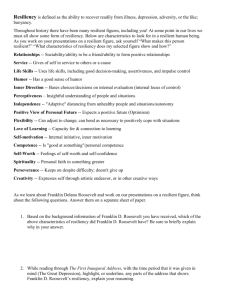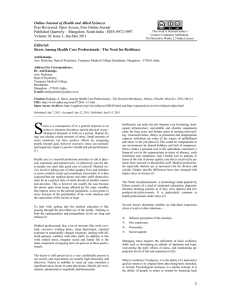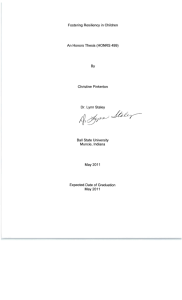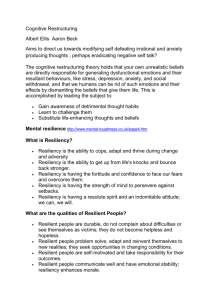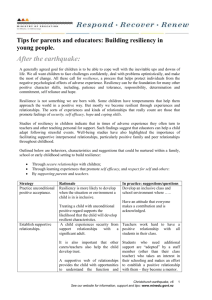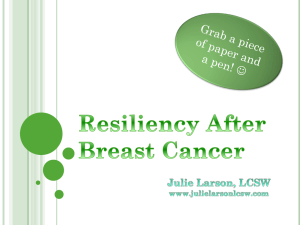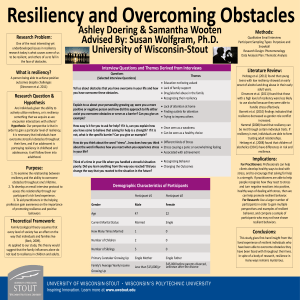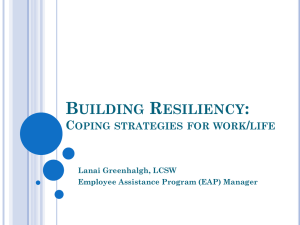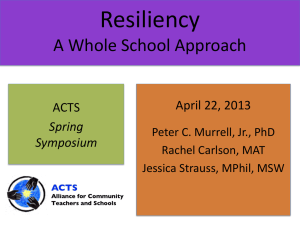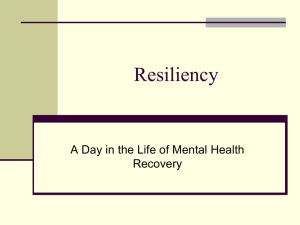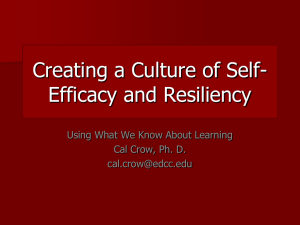File - BCVTA and POPDB Conference 2013
advertisement
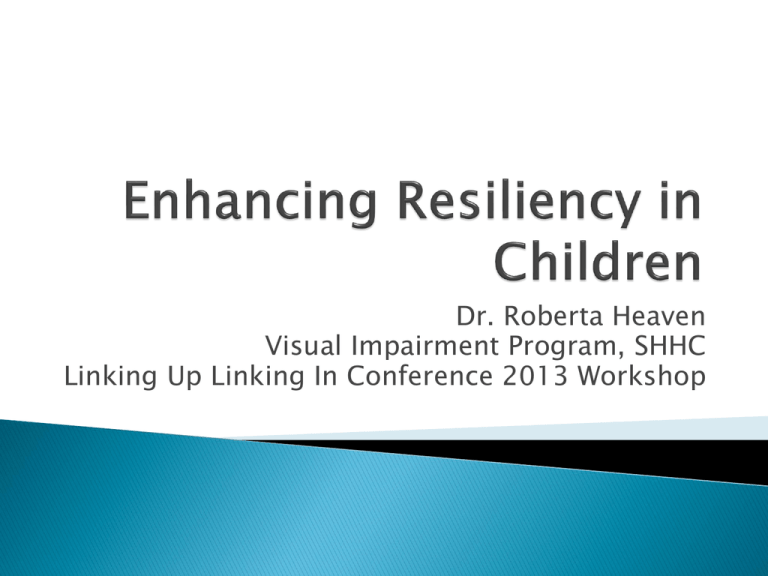
Dr. Roberta Heaven Visual Impairment Program, SHHC Linking Up Linking In Conference 2013 Workshop To understand concepts of resiliency To be aware of: risk factors Incidence in BC of Mental Health Concerns in Children and Youth Understand incidence in Students with VI Role of Parents and the Family Increasing role of Teachers and School Environment Vision teachers key position Strategies that work It is our ability to cope with change and challenges It is our ability to recover from setbacks and to react positively and adapt when things don’t go as planned. This concept has gained interest in recent years, particularly with busier, more challenging times, and greater occurrence of stress, anxiety and depression disorders among all ages in our society Is a Mindset It’s how we think How resilient are you? In our children and youth 1 in 5 Canadian children will develop a mental health concern Has been on the rise dramatically in the last 10 years. 84% of students surveyed reported stress and pressure in the previous month 14% reported it so extreme they could not cope Girls and older students more apt to report extreme stress to point of not being able to function Of those reporting major stress, 17% reported cutting or self-injury BC Adolescent Health Survey 2008 About 10 % surveyed reported health/disability Of those, this group were twice as likely to report mental health issues, extreme despair, stress, self-harm or suicidal ideation. They felt less safe at school, worse about their body image and were less likely to have long term goals Over ½ did not access support services Data sample of 100 children seen through the program 80% had subscales on the BASC-2 significantly elevated Most common are: ◦ ◦ ◦ ◦ ◦ ◦ Withdrawal Atypicality Anxiety Depression Poor Functional Communication Poor Adaptive Behaviour Skills How to? In recent years, a standardized assessment measure has been developed for children which entails a self-report questionnaire The Resiliency Scales for Children and Adolescents: A Profile of Personal Strengths Comprised of a Sense of Mastery Scale; a Sense of Relatedness Scale; and an Emotional Reactivity Scale Sense of Mastery Scale: ◦ Optimism; Self-Efficacy; Adaptability Sense of Relatedness Scale: Emotional Reactivity Scale: ◦ Trust; Support; Comfort; Tolerance ◦ Sensitivity; Recovery; Impairment ◦ Resource Index and Vulnerability Index Findings so far Observations instead Has been studied only in the last 50 years This construct is based on research indicating there are both protective factors and risk factors that impact an individual’s resiliency Protective factors include: ◦ Personal factors such as intellect, temperament and sociability ◦ Social Environment such as family factors of attachment, warmth, emotional support ◦ Key environment factors such as positive school and peer experiences Personal traits such as rigid, resistant style Significant emotional reactivity, negative outlook Poor support networks – lack of supportive family situations Lack of positive peer or school experiences Resiliency is often associated with (Ginsburg 2013) ◦ ◦ ◦ ◦ ◦ ◦ ◦ Confidence Competence Connection Character Contribution* Coping Control – sense of (external or internal) related to discipline/ consequences of real action Strategies to support these skills will also support the development of greater resiliency Some individuals are much more resilient than others Some of these traits appear to be genetic Those who are more resilient tend to be happier, better adjusted and more successful in their endeavours There is a lower incidence of mental health conditions in those who are more resilient Latest research indicates it impacts health up to 50 years later! Most importantly, literature suggests that individuals can learn to be more resilient! Role of Parents and home for little ones Not surprisingly, Parents have a key role in the development of resilient children Even when the unique individual may not be easy going by nature, they can be taught to be a problem-solver It is key for parents to be fully engaged This means being able to not just talk the talk, but walk the walk To achieve this, parents must be able to be engaged so need to be aware of their own needs and take care of themselves, and, Be committed to a set of common values, and, Commit to teaching to build skills to support positive resilient children Be aware of the pressures that can interfere: financial, employment demands, roles in the family, child behaviour and time pressures just to name a few ( may be even more relevant when children have challenges) Is important to be a resilient parent Meeting your own needs ( sleep, nutrition, down time, relationship time) Keeping perspective Support network – identifying supports and USING them Resources – such as agencies CNIB, VIP, Blind Beginnings, SHERC, Shared Vision Parenting in a family with children with unique and varied needs can provide a wealth of experience and learning Can bring parents together and unite a family in a close knit and loving way Can promote and encourage everyone to be their personal best and be grounded in what really matters So many things to teach, guide and encourage… Bonding and attachment Motor skills Communication skills Self-help and personal care skills Concepts Socialization skills Problem- solving and learning about the world Values, perspective, attitude…resilience So Busy – Overwhelming Being pulled in many directions – health needs, developmental challenges, sensory needs Other people in the family need time too Work and household demands Unique child characteristics – social/shy, easy-going/stubborn, receptive/not! Love Honesty Respect Gratitude Generosity Uniqueness Spirituality Creativity Curiosity Forgiveness Humour Positive Attitude Persistence Passion Accountability Compassion We want to encourage a love of learning in our children Not just about school but well beyond it Goal to be life long learners and have the tools to do it This means encouraging ◦ ◦ ◦ ◦ Curiosity Willingness to try new things Knowledge is powerful Mistakes can be a powerful part of learning and growth As parents we want to protect our children, and at times prevent them from learning the hard way While this is very appropriate with safety issues, we need to give them room, time, and permission to go ahead and learn for themselves too – this is critical We can give them the tools, and set up for success, but letting them do things themselves or the parts of things that they are capable of themselves is so important Having expectations that they will is also important This is especially true when our children have added challenges to being a small child such as having a visual impairment or motor challenge We may find ourselves doing things they are capable of as it is faster and we are dashing to get out the door We may not expect one child to bring their dishes to the sink as it is more difficult, but we should expect the part they can contribute – it builds sense of belonging, self-efficacy, self-esteem Fairy godmother experiences do not foster understanding We want to be part of routines and experiences Be active versus passive learners Provide the information needed to make the connections for full understanding We want them to become problem-solvers 1. What is the problem? (define objectively, specifically) 2. What are possible solutions? ( generate as many as viable) 3. Consider each possible solution ( think it through) 4. Choose the best solution and do it 5. Evaluate – Did it work? If so, great, if not, back to 3. Teaching your child a problem-solving perspective empowers them. If every challenge is merely a problem to be solved, children learn they have potential to overcome the challenge, that they can find a solution, or can get help to find it. Teaching this way of thinking is one of the most powerful things you can do as a parent to protect your child from future mental health issues such as depression. Several ways that work to help your child learn everything from basic self-care to more complex social skills: ◦ Instructions: Teaching by describing For children who have a visual impairment, they may not be able to benefit fully from vicarious learning, distant learning or details learning Providing description paired with experience Providing the Big picture as many children learn partto-whole Describing something new in terms of something they already know Modelling: teaching by showing: ◦ Demonstration ◦ Hand- over-hand or hand- under-hand Shaping: teaching by approximations Teaching step by step The early years build an expertise with your child This expertise on who your child is, how they react to new situations, what circumstances set up for the most receptive teaching moments, how they communicate allows you to inform others – daycare, preschool, kindergarten How to SET-UP-FOR-SUCCESS Children must feel safe to learn Encourage them: “ pretty soon, you will find that’s easier to do – or next time you can choose to…” Thankfully this is done in the context of what you do already everyday, but with mindfulness Quality time, attention and focus and show they matter Read with your child – endless possibilities Limit screen time – instead Play with your child even for a few minutes Talk about, and live joint family values Talk about and teach values, skills, to build selfesteem, self-efficacy and optimism through problem-solving Focus on: ◦ ◦ ◦ ◦ ◦ Family Love Sense of purpose more than happiness Who a child would like to be (as opposed to what ) Less on grades and more on learning and curiosity The importance of teachers and the school environment Remember every child is UNIQUE – with a personality and temperament all their own Taking joy in who they are and what they do helps form a positive view of self Interaction with your child in care activities, daily routines, down time, comforting and play all help build confidence, flexibility and foster secure attachment From the time we are born we are seeking to predict our environment, as we do this we build trust, confidence and are open to learning It is vital for children to feel loved, valued and a sense of belonging This starts in the family and extends to community Giving them opportunities to do tasks ( or parts of tasks) that they are capable of helps build self-confidence This also means giving opportunities for trial and error, free-play, and age-appropriate decision making Giving reasons for your decisions help children to be able to apply them also. Through these opportunities, children can build coping skills and be better able to take risks with new experiences, reach out to others, and be able to get along Give praise: describe and notice: I see you made a tower all by yourself or I like the way you …. Let them make some decisions from an early age but set up for success “ would you like to wear the blue shirt or the green shirt?” Give direction: talk about the action ( behaviour), not the child - notice positives, sandwich technique Help encourage realistic thinking ◦ Often it is not the problem but the way the child is thinking about it – spilt paint ◦ Help them label their feelings ◦ Help them to gain perspective ( not the end of the world) ◦ Only if they will talk with you can you learn what they are thinking and help them to dispel errors in thinking Encourage children to use words to express feelings and not just a physical response Provide words when they are reacting “I can see you are feeling mad right now…” A child’s understanding of feelings grows as they do A child with big emotions has a bigger job to be able to be in control of them than a more mild, easy going child Teach some strategies for managing feelings, such as self-talk, deep breaths or an action like a squishy pillow or scribble book A positive tipping point at almost any stage in school You can make a difference 6 environmental influences teachers can create: ◦ ◦ ◦ ◦ ◦ ◦ Increase prosocial bonding: Set clear, consistent boundaries: Teach “life” skills: Provide unconditional caring and support: Set and communicate high expectations: Provide opportunities for MEANINGFUL participation: Far to easy to see what’s wrong Focusing on what is wrong and trying to fix it doesn’t seem to work Instead, Look for their strengths and build on them BELIEVE It works just like THE SECRET “Children will be more resilient if the important adults in their lives BELIEVE in them UNCONDITIONALLY and hold them to HIGH EXPECTATION” It’s really all about LOVE – respect, delight in them as individuals “Children live up or down to the expectations we set for them.” KEY WORDS: Time, Nurturance, Love Must be careful not to undermine their sense of self Allow safemistakes – the most important lessons Talk in ways young people understand Keep in mind the level of thinking – where they are at (not adult) –often still concrete Don’t lecture and don’t tell them not to do…. Instead, respectfully guide them in what to do Teach Positive Coping Skills – model daily Included in this: ◦Is it real or a paper tiger ◦This too shall pass ◦Some good things remain They may – engage or disengage They may focus on emotions or problems Many of the social emotional issues – eating disorders, cutting, drug or alcohol use are coping strategies to deal with stresses Criticizing without providing alternate strategies just makes it worse Make the problem manageable - break it down Teach active avoidance – when this works Model how to let some things go Value of exercise for stress release Relaxation tools Importance of nutrition, sleep How to take a mind vacation – READ Use of emotional releases – cry, laugh, journal Change the world – one act at a time - contribute Resiliency is a child’s ability to cope or bounce-back from changes or challenges that come along in life While some people have more of this, resiliency skills can be learned Parents are key in promoting the development of these coping skills Children are children first, and any challenges they face are add-ons. Caring adults – Teachers, SEA’s, community Can make a huge difference in a child’s outcome Even with taxed schedules, the time you give can make all the difference! The children we serve are AMAZING PEOPLE Shared Vision: BC Vision teachers UBC Vision teacher and O&M Program PRCVI and SET BC CNIB BC Blind Sports Blind Beginnings Visual Impairment Program SHHC Visual Impairment Clinic QA CLVP POPDB and CDBRA www.resiliency.com has a free mentorship manual By November, 2013 a huge manual will be released in the US based on the work of Ginsberg and others The bottom line is love unconditionally and hold children in high expectations rheaven@cw.bc.ca
